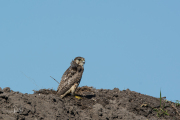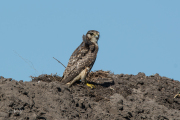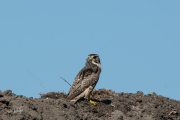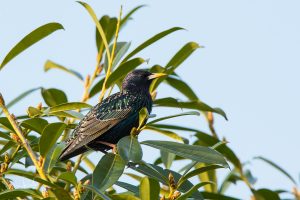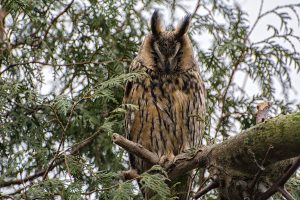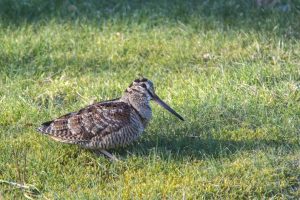A bird that always comes last during my lectures about birds of prey is one you don’t often see. Although, at this time of the year your chances to see this bird are bigger. It’s the smallest bird of prey you can find in the Netherlands and even in Europe. In proportion to the immense white tailed eagle (Haliaeetus albicilla), with almost two and a half meter wingspan also known as the flying door, with its 50-60 centimeters this is a very tiny bird of prey. I’m talking about the merlin (Falco columbarius).
Dwarf falcon
The merlin is sometimes called little or dwarf falcon and that makes sense, given its dimensions. It’s is a member of the falcon family (Falconidae), just like the peregrine falcon (Falco peregrinus), Eurasian hobby (Falco subbuteo) and kestrel (Falco tinnunculus). In terms of shape, the merlin looks most like the latter, only its wingspan is about twenty centimeters smaller. From head to tail the difference is less, about seven to ten centimeters. The colour of the female is reminiscent of a kestrel, but if you look closely you clearly see the differences. The back of a female kestrel is characteristic reddish-brown and the back of a merlin is mottled dark brown. Males are completely different, the only thing they have in common is the blue-grayish head. This colour runs across the back of the merlin, while the kestrel has a reddish-brown back. Although the differences are clear, in the field you have to pay close attention to recognize it. Especially when its flying over and you have no reference for the size.
Winter guest
In summer you won’t find any merlins in the Netherlands. Their breeding area is on the Scandinavian and Russian tundras, but also the highlands of Scotland. Between mid-September and the end of October, move to warmer regions to overwinter. Some of them migrate over the Netherlands, but as long as it is not too cold there are also some birds that stay here. Especially in open areas in the western and northern Netherlands. And if it gets too cold after all, they move further southwards. And around mid-March until the end of May they migrate back to their breeding grounds in the north. In some places along the Dutch coast, for example in the outermost tip of Groningen, but also at Breskens in Zeeuws-Vlaanderen, sometimes dozens of merlins are counted flying over during migration. For several decades there has been a decline with fewer and fewer merlins staying in the Netherlands every winter.
A bit of dynamite
A merlin uses a different hunting technique than its family members. For example, it doesn’t hover like a kestrel. It mainly hunts small birds, such as the meadow pipit (Anthus pratensis), skylark (Alauda arvensis), common linnet (Linaria cannabina)and European Stonechat (Saxicola rubicola). Especially birds from the countryside and heaths. That’s where the merlin is in its element. The bird often sits on a pole waiting to have a prey in sight, sometimes hundreds of meters away. And then, in a split second, it flies low and fast towards the little birds, which are for example unsuspectingly foraging on the ground. When they fly away the merlin hits the prey in flight. And when the prey tries to escape, the merlin continues to chase the little bird, sometimes as long as five to ten minutes, until it’s too tired to escape. Merlins will also follow skylarks and meadow pipits high up in the sky. They try to get above them and then hit them in a dive.
Pigeons
The merlin owes its scientific name to the pigeon. Where you would immediately think of the similarity in terms of format. Columbarius comes from the Latin columba, which means pigeon. When in 1758 Linnaeus was thinking of a scientific name to assign to the merlin, the English naturalist Mark Catesby had already used the name Accipiter palumbarius for the North American merlin. And palumba too comes from the Latin word for pigeon. (Just think about the “Paloma Blanca” from the famous song of the George Baker Selection.) To make things even easier, in Europe the scientific name Accipiter palumbarius was already used for the northern goshawk! Later the northern goshawk got its current scientific name Accipiter gentilis. The goshawk, the sparrowhawk and the falcons were at that time still seen as belonging to one family. But Linnaeus saw that there were important differences between these species, so he conceived the new family of the falcons. The genus name Falco derives from the Late Latin ‘falx’ or ‘falcis’ which means sickle, refferring to the claws of the bird. Both the North American and Eurasian merlin are subspecies of the Falco columbarius and nowadays they have the same scientific name.
Partridge hunt
So the merlin got its name Falco columbarius, contained a reference to pigeons. For a long time it was assumed that this name came from the size of the merlin, but Catesby invented it because the bird did indeed strike pigeons. The merlin was also used for hunting, especially by ladies. Because of the bird’s small size and weight, it was more manageable than the other species, such as the peregrine falcon. In the 1635 Dutch book “Jacht Bedryff” (referring to hunting techniques) by Cornelis Jacobszoon van Heenvliet, the author writes about the hunting with merlins.”much was used on larks, and also on partridge”. So it was also used for the hunting of partridges, not the smallest bird species. This shows what a powerful bird the merlin is. It is also known that the Russian Czarina Katharina II used the merlin for hunting, mainly on larks and thrushes. But not everyone agrees about this origin of the scientific name and keep referring to the size of the bird.
Old Frankish origin
The name merlin would be derived from the old French name ‘esmeril’, which comes from the Old Frankish ‘smiril’, in the meaning of little or dwarf falcon. It is also cognate with the Old High German ‘Smirl’. There are different theories about the origin of this French and German name. However, they are still somewhat reflected in the contemporary French and German names for the bird, respectively ‘faucon émerillon’ and ‘Merlin’. And of course also in the English name ‘merlin’.
If you are in the field this winter and you see a small bird of prey flying fast above the field at a height of about one meter, then chances are that it’s a merlin. I myself got the chance last spring to photograph a female. Where I had to act quickly to make some pictures, because before I knew it had already flown. Hunting, chasing the little birds.
Sources:
- www.sovon.nl (in Dutch)
- www.wnve.nl (in Dutch)
- www.etymologiebank.nl (in Dutch)
- www.vogelbescherming.nl (in Dutch)
- www.knnv.nl (in Dutch)
- www.merriam-webster.com
- en.wiktionary.org
- en.wikipedia.org



